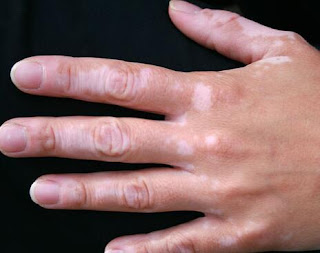Vitiligo is a continual and long-term skin problem that produces patches of
white depigmentation that develop and enlarge in certain sections of the
skin.
Treatment may help make the skin look more even. The choice of treatment depends on:
The number of white patches
How widespread the patches are
The treatment the person prefers to use.
Some treatments are not right for everyone. Many treatments can have unwanted side effects. Treatments can take a long time, and sometimes they don’t work.
Current treatment options for vitiligo include medical, surgical, and other treatments. Most treatments are aimed at restoring color to the white patches of skin.
Medical treatments include:
Medicines (such as creams) that you put on the skin
Medicines that you take by mouth
A treatment that uses medicine plus ultraviolet A (UVA) light (PUVA)
Removing the color from other areas so they match the white patches.
Surgical treatments include:
Skin grafts from a person’s own tissues. The doctor takes skin from one area of a patient’s body and attaches it to another area. This is sometimes used for people with small patches of vitiligo.
Tattooing small areas of skin.
Other treatments include:
Sunscreens
Cosmetics, such as makeup or dye, to cover the white patches
Counseling and support.
Home Remedies Treatment Vitiligo
The following self-care tactics may help you care for your skin and improve its appearance:
Protect your skin from the sun and artificial sources of UV light. If you have vitiligo, particularly if you have light skin, use a broad-spectrum, water-resistant sunscreen with an SPF of at least 30. Apply sunscreen generously and reapply every two hours — or more often if you're swimming or perspiring.
You can also seek shade and wear clothing that shields your skin from the sun.
Protecting your skin from the sun helps prevent sunburn and long-term damage. A bad sunburn can make your condition worse. Sunscreen also minimizes tanning, which makes the contrast between normal and discolored skin less noticeable.
Conceal affected skin. Concealing products may improve the appearance of the skin and help you feel better about yourself, especially if your vitiligo patches are on exposed skin. You may need to try several brands of makeup or self-tanners to find one that blends well with your normal skin tone. The coloring of self-tanning products doesn't wash off, but it gradually fades over several days. If you use a self-tanner, select one that contains dihydroxyacetone, as it is approved by the Food and Drug Administration.
Don't get a tattoo. Avoid tattooing that's not related to treating your vitiligo. Damage to your skin, such as that caused by a tattoo, may cause a new patch of vitiligo to appear within two weeks.
Treatment may help make the skin look more even. The choice of treatment depends on:
The number of white patches
How widespread the patches are
The treatment the person prefers to use.
Some treatments are not right for everyone. Many treatments can have unwanted side effects. Treatments can take a long time, and sometimes they don’t work.
Current treatment options for vitiligo include medical, surgical, and other treatments. Most treatments are aimed at restoring color to the white patches of skin.
Medical treatments include:
Medicines (such as creams) that you put on the skin
Medicines that you take by mouth
A treatment that uses medicine plus ultraviolet A (UVA) light (PUVA)
Removing the color from other areas so they match the white patches.
Surgical treatments include:
Skin grafts from a person’s own tissues. The doctor takes skin from one area of a patient’s body and attaches it to another area. This is sometimes used for people with small patches of vitiligo.
Tattooing small areas of skin.
Other treatments include:
Sunscreens
Cosmetics, such as makeup or dye, to cover the white patches
Counseling and support.
Home Remedies Treatment Vitiligo
The following self-care tactics may help you care for your skin and improve its appearance:
Protect your skin from the sun and artificial sources of UV light. If you have vitiligo, particularly if you have light skin, use a broad-spectrum, water-resistant sunscreen with an SPF of at least 30. Apply sunscreen generously and reapply every two hours — or more often if you're swimming or perspiring.
You can also seek shade and wear clothing that shields your skin from the sun.
Protecting your skin from the sun helps prevent sunburn and long-term damage. A bad sunburn can make your condition worse. Sunscreen also minimizes tanning, which makes the contrast between normal and discolored skin less noticeable.
Conceal affected skin. Concealing products may improve the appearance of the skin and help you feel better about yourself, especially if your vitiligo patches are on exposed skin. You may need to try several brands of makeup or self-tanners to find one that blends well with your normal skin tone. The coloring of self-tanning products doesn't wash off, but it gradually fades over several days. If you use a self-tanner, select one that contains dihydroxyacetone, as it is approved by the Food and Drug Administration.
Don't get a tattoo. Avoid tattooing that's not related to treating your vitiligo. Damage to your skin, such as that caused by a tattoo, may cause a new patch of vitiligo to appear within two weeks.





